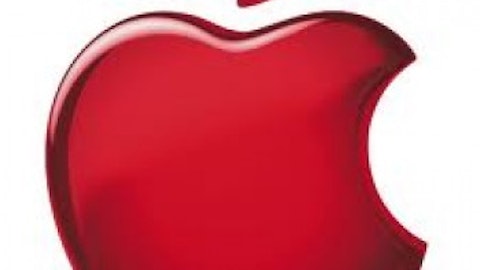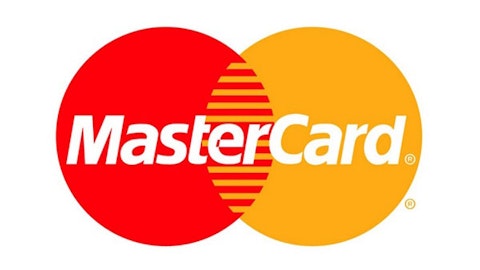Most of the negativity surrounding Apple Inc. (NASDAQ:AAPL) seems to be focused on the belief that the company has allegedly lost its status as a leading growth stock. Apple is strictly secretive about new product launches, so there is no way to know for certain what’s in its pipeline of new products. With competitors like Samsung gaining market share in emerging markets, many believe that Apple is now a mature business with uninspiring growth opportunities.
However, there are several reasons to believe investors may be underestimating the company’s true growth potential, and this could have material bullish implications for the stock.
Trading at a forward P/E around 9, Apple Inc. (NASDAQ:AAPL) is certainly not priced for growth. But if we look at the last quarter, which was a big disappointment to many investors and produced a brutal drop of 12% in the stock price, the company doesn’t seem to be doing that bad.
Revenue growth was 18% annually for the quarter, but if we consider that last year included an extra week, adjusted revenue growth would have been 27%. Looking at the two biggest product lines, iPhone sales increased by 29% annually, while iPads showed an increase of more than 48%. Macs and iPods are being displaced by the iPad and the iPhone, respectively, so sales of these products fell during the quarter. Overall revenues were below analyst forecasts for the quarter, but we could hardly say that Apple Inc. (NASDAQ:AAPL) is not a growth company by looking at sales numbers.
Earnings per share increased by an adjusted 7% annually. Lower margins were already expected due to new product launches and both gross and operating margins were above estimates, but falling steeply from previous levels. So, Apple has chosen to put new products over short-term profitability, and Wall Street seems to be punishing the company for lackluster earnings growth.
On Growth and Innovation
Apple Inc. (NASDAQ:AAPL) has launched new products, and that has reduced profitability, at least temporarily. That’s one of the best indications of an innovative growth culture you can possibly find.
Amazon.com, Inc. (NASDAQ:AMZN) is trading at historical highs in spite of the fact that the company has destroyed profitability in the quest for market share gains, yet investors are not looking at Apple Inc. (NASDAQ:AAPL) in the same way. Don’t get me wrong, Amazon is doing the right thing — when you have the opportunity to consolidate a leadership position in spectacular business areas like online retail and cloud computing, thinking about long-term competitive position as opposed to short-term profit margins is the smart thing to do.
Apple is going in the same direction — the iPad Mini has a lower profit contribution per unit, and it cannibalizes the more profitable iPad models. Yet it has been a fantastic success by Apple Inc. (NASDAQ:AAPL)’s standards, as it managed to deliver a high-quality device that is accessible to consumers for a lower price and selling remarkably well.
From Tim Cook during Goldman Sachs’ Technology and Internet conference:
“Over 50% of the people in countries like China and Brazil that were buying an iPad don’t own an Apple product. This is a huge thing for us to go out and show people what Apple is and introduce them to the company. Through the years, we’ve found a very clear correlation between people getting in and buying their first Apple product and some percentage of them buying other Apple products.
“You can go in and accept a lower margin on any product for a strategic reason. That strategic reason might be our entry into that area. At the background, we always know that this halo effect play, we had confidence in our ability to execute the supply chain and walk down costs. In the area of tablets, we think the market is huge and it makes sense to have another product there. People wanted a full iPad experience, but in something smaller and lighter. We have other ways to make money and reward shareholders.”
On Emerging Markets and Pricing
Pricing is seen as a limitation for Apple in emerging markets, where the carrier subsidy model is not as popular as in the US, income levels are lower and the iPhone can be too expensive. But the company is working its way around that problem — the iPhone 4 and iPhone 4S are sold for aggressively low prices, and according to Cook there was not enough supply of iPhone 4 to meet demand in the last quarter.
Just like the iPod started at $399 and customers can now buy an iPod Shuffle for $49, the company is taking the same approach to the iPad and the iPhone. The company will always be positioned in the high end of the pricing spectrum in terms of competition, but that doesn’t mean that Apple products will necessarily be too expensive for emerging markets.
China is already Apple’s second biggest market, and it’s still a fantastic opportunity for the company in terms of growth: including retail sales, revenue was up 60% in the country during the last quarter. And that’s in spite of the fact that Apple has not still reached an agreement with the biggest Chinese carrier, China Mobile Ltd. (ADR) (NYSE:CHL), regarding the iPhone.
With more than 700 million customers, China Mobile could provide a considerable boost to Apple in China, and the carrier would benefit materially by gaining access to a product much desired by the growing Chinese middle class. Both companies have been in conversations for a long time, and Tim Cook last met with China Mobile’s Chairman Xi Guohua in January over “matters of cooperation.” Both Apple and China Mobile have a lot to gain from an agreement, so it sounds logical to assume one will be reached sooner rather than later.
Different Growth Venues
Apple is admittedly working on a new Apple TV, and Bloomberg has recently reported that the company has about 100 employees working on an iWatch. The possibilities are limitless when it comes to new products in the middle and long term, so there is no reason to discard new and disruptive innovations from the company. Only because Apple hasn’t launched any new mind-blowing product since the iPad in 2010, that doesn’t mean that innovation is over at Cupertino.
The iTunes store is now operating in more than 100 countries, and Asymco estimates that it generates nearly $12 billion in gross annual revenue. Asymco calculates that total revenues generated by iTunes have risen steadily in a range of 32% to 38% compounded over the last four years. As customers continue purchasing higher-priced products like eBooks and movies, and not only $1 songs, iTunes should deliver increased profitability over the next years.
The Apple store is not only a genius marketing move by the company, it’s also the most efficient retailer in the US in terms of sales per square foot, and it has plenty of opportunities for expansion, especially in international markets, which are still almost untapped by Apple stores. The Apple store is a great business in itself, and it also has very positive implications in terms of product sells and brand differentiation for the company.
Bottom Line
Growth should not be measured in terms of quarterly earnings evolution; it’s a matter of corporate culture, innovation and opportunities. Seen from that perspective, Apple is still a growth stock.
The article Apple is Still a Growth Stock originally appeared on Fool.com and is written by Andrés Cardenal.
Copyright © 1995 – 2013 The Motley Fool, LLC. All rights reserved. The Motley Fool has a disclosure policy.





